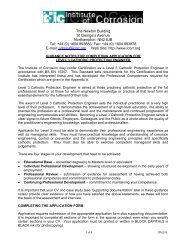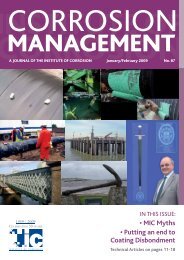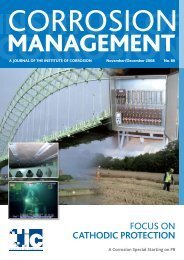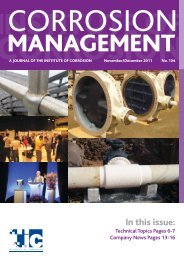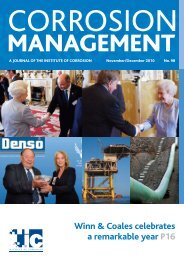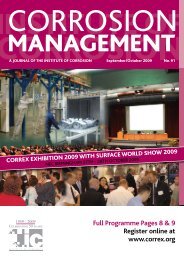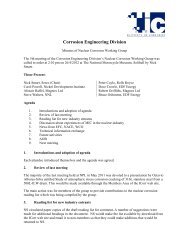In this issue: - the Institute of Corrosion
In this issue: - the Institute of Corrosion
In this issue: - the Institute of Corrosion
You also want an ePaper? Increase the reach of your titles
YUMPU automatically turns print PDFs into web optimized ePapers that Google loves.
INSTITUTENEWSQ. <strong>Corrosion</strong> control and asset integritymanagement are certainly discreteconcepts but are very much related. Howwould you explain both concepts?A. For <strong>of</strong>fshore assets, corrosion is not <strong>the</strong> onlythreat, but it is a significant and major threatto asset integrity. Asset integrity managementfrom my point <strong>of</strong> view is <strong>the</strong> intelligentdeployment <strong>of</strong> initially front-end risk-basedinspection and monitoring coupled withwell thought out application <strong>of</strong> <strong>the</strong> variouscorrosion control techniques.Q. What do you consider <strong>the</strong> maincomponents <strong>of</strong> a good asset integritymanagement system? What are <strong>the</strong> keybenefits <strong>of</strong> implementing an asset integritymanagement system?A. Starting with <strong>the</strong> second question, <strong>the</strong> keybenefits are to ensure Health, Safety andEnvironment (HSE) compliance and to keep<strong>the</strong> asset stakeholders happy by operating apr<strong>of</strong>itable venture. Downtime and catastrophicfailure are certainly unacceptable in today’sbusiness, so integrity risks to <strong>the</strong> asset mustbe well-managed. The most important aspect<strong>of</strong> a successful asset integrity managementprogramme starts with an intelligent risk-basedinspection programme. Unfortunately, many<strong>of</strong> <strong>the</strong>se programmes are not well thought outand are very <strong>of</strong>ten wasteful and not focusedon <strong>the</strong> key corrosion threats. Ano<strong>the</strong>r key pointis to get senior management to support <strong>the</strong>programme. If senior management supportsan asset integrity management system, it ismore likely to succeed. Thirdly, it is vital that<strong>the</strong> practitioners are competent. If you haveunqualified personnel involved in any aspect<strong>of</strong> <strong>the</strong> programme, it will be a weak link andrisk will be elevated. So in summary, seniormanagement support, good programmes andgood people are <strong>the</strong> main factors to considerwhen developing asset integrity managementsystems.Q. Experts have always emphasised <strong>the</strong>importance <strong>of</strong> reviewing asset integritymanagement systems regularly to ensure<strong>the</strong>y remain fit for <strong>the</strong>ir purpose. Why doyou think <strong>this</strong> is important?A. It is absolutely critical to do <strong>this</strong> for somereasons that I will pick on although <strong>the</strong>re areprobably more. The first is <strong>the</strong> dynamic nature<strong>of</strong> corrosion risk as <strong>the</strong> asset ages. There willbe changes in corrosion models, reservoircorrosivity, constituents and o<strong>the</strong>r parameters,so <strong>the</strong> model and risk for corrosion damageare continually varying. Therefore, as <strong>the</strong> assetages, <strong>the</strong>re is a changing criticality that mustbe continually reviewed. Ano<strong>the</strong>r reason tocontinually review <strong>the</strong> system is to ensureyou get <strong>the</strong> loop effect <strong>of</strong> feeding resultsfrom integrity activities into <strong>the</strong> decisionmakingprocess to ensure intelligent changesare made to <strong>the</strong> system. Ano<strong>the</strong>r obviousreason to review is <strong>the</strong> development <strong>of</strong> newtechnology. There is a regular introduction <strong>of</strong>better ways <strong>of</strong> doing everything in integritymanagement, such as new inspection tools,new subsea equipment, new materials, newways <strong>of</strong> producing oil and gas — especially in<strong>the</strong> subsea industry — and deep-water sectors.So what worked well in <strong>the</strong> beginning <strong>of</strong> <strong>the</strong>field life may be inappropriate fur<strong>the</strong>r into <strong>the</strong>asset’s service life. Finally, <strong>the</strong> review <strong>of</strong> <strong>the</strong>system is consistent with HSE requirementsthat are placed on oil and gas companies.Q. It is no secret that oil and gas assets areincreasingly required to function beyond<strong>the</strong>ir original design life. There is now aneed to perform life-extension studies toprove <strong>the</strong>se assets can continue in service.What do you think is <strong>the</strong> primary role <strong>of</strong><strong>the</strong> corrosion pr<strong>of</strong>essional in <strong>this</strong> process?A I think <strong>the</strong> primary role <strong>of</strong> <strong>the</strong> corrosionpr<strong>of</strong>essional is to provide advice to <strong>the</strong>stakeholders and asset owners on <strong>the</strong> threatthat specific types <strong>of</strong> corrosion damage poseto <strong>the</strong> integrity <strong>of</strong> <strong>the</strong>ir asset. Not all corrosionelevates risk, so corrosion pr<strong>of</strong>essionals shouldbe able to advise on where risk-increasingcorrosion mechanisms exist and what <strong>the</strong>ireffects are. Also, <strong>the</strong> corrosion engineer mustinteract effectively with o<strong>the</strong>r disciplines tounderstand how o<strong>the</strong>r relevant parameterscan affect corrosion. For example, a change infatigue life could reduce <strong>the</strong> tolerance <strong>of</strong> anasset to corrosion. <strong>In</strong> <strong>this</strong> case, <strong>the</strong> structuraland corrosion engineers must combine <strong>the</strong>irindividual expertise to ensure that adequateassessments are made to quantify and control<strong>the</strong> combined risk <strong>of</strong> fatigue and corrosion.Q. What are <strong>the</strong> main challenges facing<strong>the</strong> UK upstream oil and gas sector asmost assets approach <strong>the</strong> end <strong>of</strong> <strong>the</strong>irservice life?A. I think <strong>the</strong>re are two major challengesthat are specifically brought about by aginginfrastructure. First is finding <strong>the</strong> monetarycapital to decommission <strong>the</strong> asset. Ano<strong>the</strong>rchallenge to <strong>the</strong> industry is maintaining <strong>the</strong>asset’s integrity and fitness for purpose ona very tight budget. There are many morechallenges but I think <strong>the</strong>se are <strong>the</strong> keychallenges <strong>the</strong> industry faces and will continueto face in <strong>the</strong> future.Q. The interview will not be completewithout a question relating to cathodicprotection because you have done a lot<strong>of</strong> work in developing cathodic protectionretr<strong>of</strong>it technologies. From your point<strong>of</strong> view, do you think <strong>the</strong>re is a goodunderstanding <strong>of</strong> cathodic protection in <strong>the</strong>industry? What are <strong>the</strong> common mistakesin its application?A. I am amazed at <strong>the</strong> amount <strong>of</strong> fundamentalignorance that pervades <strong>the</strong> industry when itcomes to cathodic protection. There are a lot<strong>of</strong> misconceptions, but I will mention <strong>the</strong> twomost common. The first is <strong>the</strong> insistence bysome engineers that cathodic protection is aline <strong>of</strong> sight wave phenomenon ra<strong>the</strong>r than anelectrochemical mechanism, thus <strong>the</strong> classicmisconception arises that if an anode cannot“see” <strong>the</strong> structure <strong>the</strong>n cathodic protectioncannot be achieved. The second commonmistake is <strong>the</strong> lack <strong>of</strong> appreciation for <strong>the</strong>fundamental principle <strong>of</strong> cathodic protection,such as <strong>the</strong> crowding up <strong>of</strong> sacrificial anodearrays onto skids with a complete disregard<strong>of</strong> mutual interference effects, and <strong>this</strong> hasled to high pr<strong>of</strong>ile deployment <strong>of</strong> anodes thathave been massively under-protective. I think<strong>the</strong>re is a need for more awareness <strong>of</strong> <strong>the</strong>fundamentals <strong>of</strong> cathodic protection in <strong>the</strong>industry.Q. Do you have any advice for <strong>the</strong>corrosion pr<strong>of</strong>essionals joining <strong>the</strong> oil andgas industry (especially in <strong>the</strong> North Sea)?What prospects do you see for <strong>the</strong> future<strong>of</strong> <strong>the</strong> industry?A. I would say to any young pr<strong>of</strong>essional thatcorrosion is a good pr<strong>of</strong>ession which is stillunder-populated, and I would recommend itas a career choice. <strong>Corrosion</strong> is not confinedto <strong>the</strong> oil and gas sector and indeed, in <strong>the</strong><strong>of</strong>fshore sector, it is branching into o<strong>the</strong>rareas such as renewables. I would, however,advise any entry level or graduate corrosionpr<strong>of</strong>essional to get a job where <strong>the</strong>y can getpractical field exposure to corrosion because<strong>this</strong> will positively develop a fundamentalknowledge <strong>of</strong> corrosion and enhance careeropportunities in <strong>the</strong> future. <strong>Corrosion</strong> in <strong>the</strong> oiland gas industry has a very good prospect, butone must be willing to travel regularly and/or possibly relocate because it is essentially amobile industry.The members <strong>of</strong> <strong>the</strong> Aberdeen branchcommittee would like to thank Jim Brittonfor his contribution to our interview series.We would also like to commend him for hiscontinued commitment to <strong>the</strong> development<strong>of</strong> corrosion technologies and his supportfor our branch activities. This interview hasbeen conducted by <strong>the</strong> <strong>In</strong>stitute <strong>of</strong> <strong>Corrosion</strong>(ICorr) Aberdeen branch committee. Moreinformation about branch activities can beobtained from <strong>the</strong> ICorr Aberdeen branchsecretary, Frances Blackburn, ICorrABZ@gmail.com. Alternatively, a calendar <strong>of</strong> local events<strong>of</strong> interest to corrosion pr<strong>of</strong>essionals in <strong>the</strong>Aberdeen area and <strong>the</strong> opportunity to signup for <strong>the</strong> branch’s mailing list is available athttps://sites.google.com/site/icorrabz/home.9



